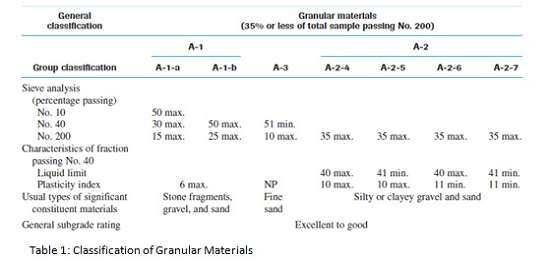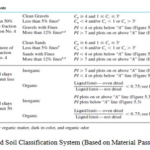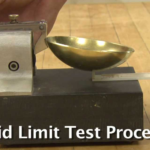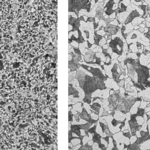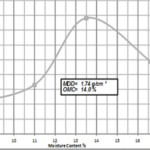Introduction
AASHTO stands for American Association of State Highway and Transportation Officials. AASHTO proposed soil classification in 1929 and had undergone several revisions till now with the present version proposed by the Committee on Classification of Materials for Subgrades and Granular Type Roads of the Highway Research Board in 1945 (ASTM designation D-3282; AASHTO method M145). It is widely used to classify soil and soil-aggregate mixtures for construction of roads, highways, and airfield (runways, taxiways) especially for sub-grade material.
Objective(s) of the Experiment
This practical is carried out to classify soils according to AASHTO method of classification
Equipments and Materials Needed
- Set of U.S. Sieves
- Atterberg Limit Tests Apparatus
- Weighing Balance
- Drying Oven
Procedures
The AASHTO classification in present use is given in Table 1 and 2 below. According to this system, soil is classified into seven major groups: A-1 through A-7. Soils classified under groups A-1, A-2, and A-3 are granular materials of which 35% or less of the particles pass through the No. 200 sieve. Soils of which more than 35% pass through the No. 200 sieve are classified under groups A-4, A-5, A-6, and A-7. These soils are mostly silt and clay-type materials.
This classification system is based on the following criteria:
- Grain size:
- Gravel: Fraction passing the 75-mm sieve and retained on the No. 10 (2-mm) U.S. sieve.
- Sand: Fraction passing the No. 10 (2-mm) U.S. sieve and retained on the No. 200 (0.075-mm) U.S. sieve
- Silt and clay: Fraction passing the No. 200 U.S. sieve
- Plasticity: The term silty is applied when the fine fractions of the soil have a plasticity index of 10 or less. The term clayey is applied when the fine fractions have a plasticity index of 11 or more. Note that Plasticity = Liquid Limit – Plastic Limit (i.e. LL – PL).
- If cobbles and boulders (size larger than 75 mm) are encountered, they are excluded from the portion of the soil sample from which classification is made. However, the percentage of such material is recorded.
Please click on the tables below to view the full size
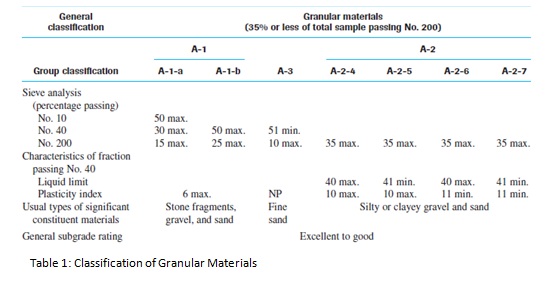

Notes:
- For A-7-5, PI ≤ LL – 30
- For A-7-6, PI > LL – 30
To classify a soil according to Tables 1 and 2, one must apply the test data from left to right. By process of elimination, the first group from the left into which the test data fit is the correct classification. Figure 1 shows a plot of the range of the liquid limit and the plasticity index for soils that fall into groups A-2, A-4, A-5, A-6, and A-7.
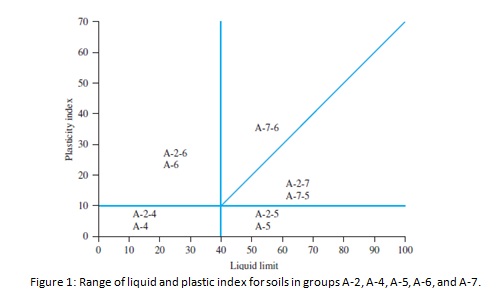
Group Index (GI)
To evaluate the quality of a soil as a highway subgrade material, one must also incorporate a number called the group index (GI) with the groups and subgroups of the soil. This index is written in parentheses after the group or subgroup designation. The group index is given by the equation:
GI = (F200 – 35) [0.2 + 0.005 (LL – 40)] + 0.01 (F200 – 15) (PI – 10)………. Eq. (1)
Where
F200 = percentage passing through the No. 200 sieve
LL = Liquid Limit
PI = Plasticity Index
The first term of Eq. (1) — that is, (F200 – 35) [0.2 + 0.005 (LL – 40)] — is the partial group index determined from the liquid limit. The second term—that is, 0.01 (F200 – 15) (PI – 10) — is the partial group index determined from the plasticity index.
Rules for Determining the GI
Following are some rules for determining the group index:
- If Eq. (1) yields a negative value for GI, it is taken as 0.
- The group index calculated from Eq. (1) is rounded off to the nearest whole number (for example, GI = 3.4 is rounded off to 3; GI = 3.5 is rounded off to 4).
- There is no upper limit for the group index.
- The group index of soils belonging to groups A-1-a, A-1-b, A-2-4, A-2-5, and A-3 is always 0.
- When calculating the group index for soils that belong to groups A-2-6 and A-2-7, use the partial group index for PI, or Eq. (2). GI = 0.01 (F200 – 15) (PI – 10)……..Eq. (2)
Discussion and Conclusion
In general, the quality of performance of a soil as a subgrade material is inversely proportional to the group index.
References
- Das, B.M.and Sobhan, K. (2014). “Principles of Geotechnical Engineering Eighth Edition, SI”
- Wikipedia “AASHTO Soil Classification System”. http://en.wikipedia.org/wiki/AASHTO_Soil_Classification_System.html Assessed on February 28, 2018.
- Engineersdaily.com “AASHTO Soil Classification System”. http://www.engineersdaily.com/2011/03/aashto-soil-classification-system.html Assessed on February 28, 2018.
